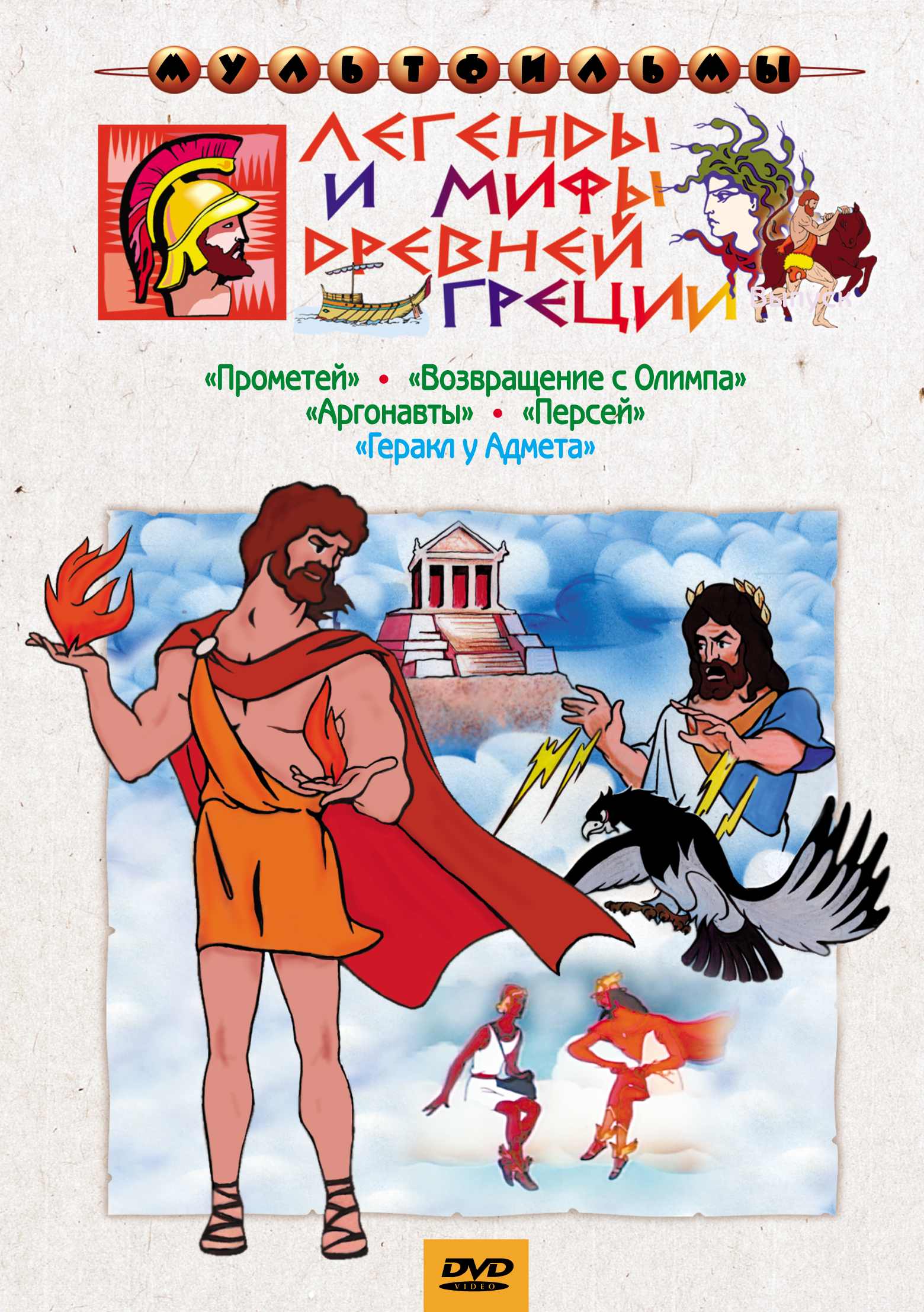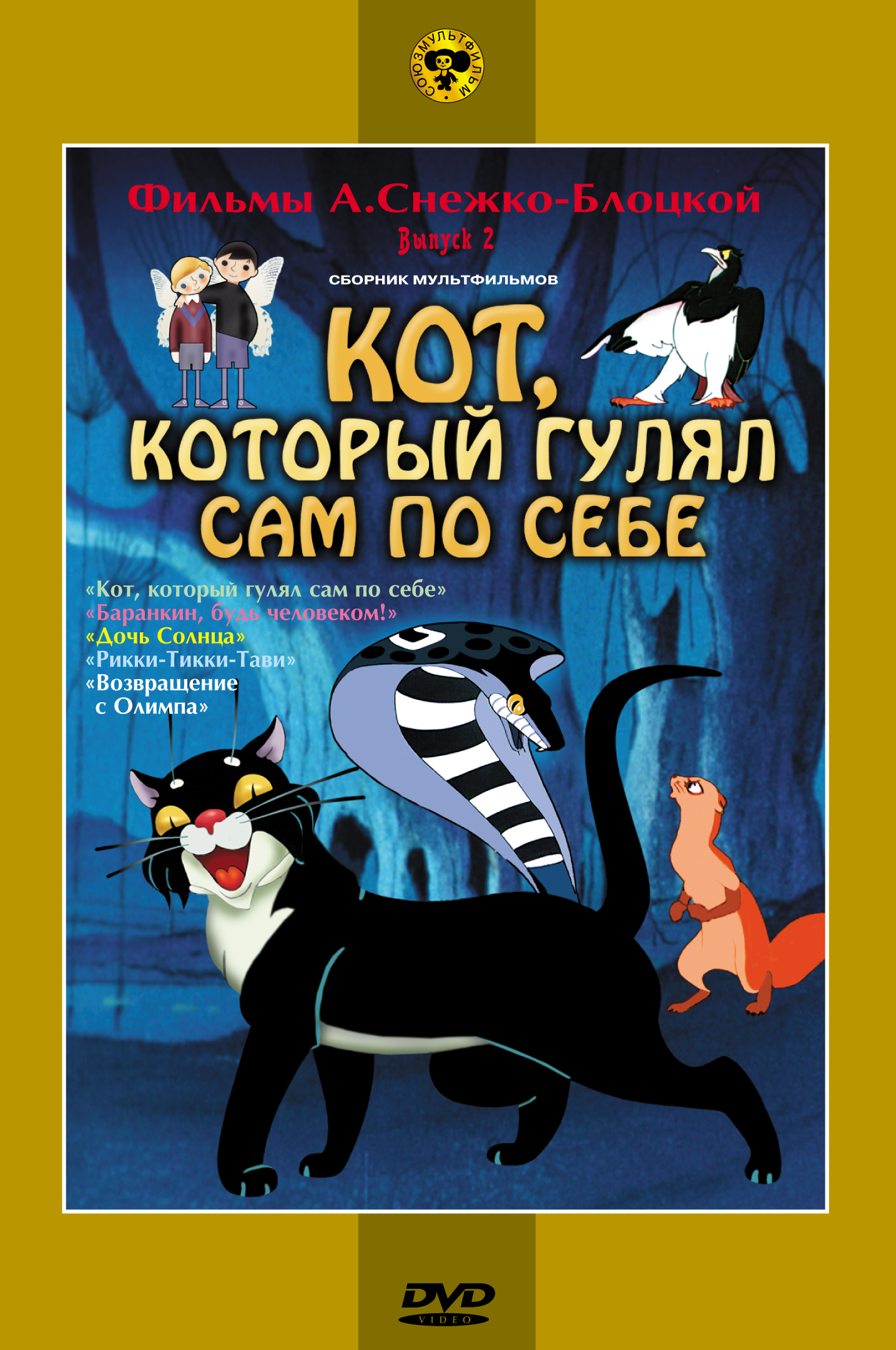Title of the work
Studio / Production Company
Country of the First Edition
Country/countries of popularity
Original Language
First Edition Date
First Edition Details
Возвращение с Олимпа [The Return from Olympus (Vozvrashchenie s Olimpa)]. Directed by Aleksandra Snezhko-Blotskaia, script by Aleksei Simukov. Moscow: Soyuzmultfilm, 1969.
Running time
Date of the First DVD or VHS
Available Onllne
The movie is available on the “Soyuzmultfilm” YouTube channel (accessed: August 17, 2018).
Genre
Animated films
Hand-drawn animation (traditional animation)*
Myths
Short films
Target Audience
Children (6+)
Cover

The cover of the entire series Legends and Myths of Ancient Greece.

The cover of the collection of Snezhko-Blotskaia's animations. Courtesy of the Film Video Association "Крупный план” [Close-up (Krupnyĭ plan)] close-up.ru, (accessed: August 17, 2018).
Author of the Entry:
Hanna Paulouskaya, University of Warsaw, hannapa@al.uw.edu.pl
Peer-reviewer of the Entry:
Elżbieta Olechowska, University of Warsaw, elzbieta.olechowska@gmail.com
Lisa Maurice, Bar-Ilan University, lisa.maurice@biu.ac.il

Aleksei Simukov
, 1904 - 1995
(Screenwriter, Scriptwriter)
Aleksei Simukov was born in St Petersburg, in a family belonging to the intelligentsia. He received classical education at the Third Classical Gymnasium (the only one in St Petersburg where Greek and Latin was taught at the time). In 1925 Aleksei Simukov moved to Moscow. He studied at the art studio of Ilya Mashkov at the Association of the Artists of Revolutionary Russia (AKhRR) and also at the Maxim Gorky Literature Institute.
He began writing plays for theatre and cinema, including animation. He preferred comical and lyrical genres, following the tradition of the 19th-century Russian theatre.
Aleksei Simukov was a lecturer at the Maxim Gorky Literature Institute. He was a literary editor of the Soyuzmultfilm studio (1944–1946), worked at the Ministry of cinematography of the USSR (1947–1950), later at the Union of Soviet Writers (1950s), and still later at the Theatre Department of the Ministry of Culture of the USSR (1964–1971) having influence on the repertory of the theaters in the country.
In his memoirs Simukov writes about scripts for the movies of Aleksandra Snezhko-Blotskaia about the Greek mythology. He says that at that time he became fascinated by myths. They inspired him to continue developing this theme and he also wrote two plays about the Greek mythology. These were Гори, гори ясно (Burn, Burn, Brightly) about Heracles and Prometheus, and Взгляд Медузы (A Glance of Medusa) about Perseus.
His life spanned pre-revolutionary and post-Soviet Russia; he finished his memoirs in 1994, a year before he died.
Source:
Simukov, Aleksei, Чертов мост, или Моя жизнь как пылинка Истории [A Devil's Bridge or My Life as a Speck of History], Moskva: Agraf, 2008.
Bio prepared by Hanna Paulouskaya, University of Warsaw, hannapa@al.uw.edu.pl

Aleksandra Snezhko-Blotskaia
, 1909 - 1980
(Director)
Aleksandra Snezhko-Blotskaia was a Russian animator and movie director.
Born in Vovchansk in Kharkiv Oblast (today in Ukraine), she later moved to Moscow oblast and Moscow. In 1925–26 she studied at the Fëdor Rerberg Art School. In 1926 she joined an art studio at the Association of the Artists of Revolutionary Russia (AKhRR). She also studied at the Architecture and Construction Institute.
From 1934 she worked at animation. First, at the Союзкинотехника ([Soviet] Union Cinema Techniques), then at the Experimental Cartoon Studio directed by Victor Fëdorovich Smirnov, at the Межрабпомфильм (Movies for Workers International Relief). She started as animator, then for a long time worked as assistant-director for Ivan Ivanov-Vano. From 1956 she worked independently and produced film adaptations of fairy tales of different nations: Verlioka (a Russian folktale, 1957), Янтарный замок ([An Amber Castle], a Lithuanian folktale, 1959), Дракон ([A Dragon], a Burmese folktale, 1960–61), Чудесный сад ([A Miraculous Garden], a Kazakh folktale, 1962), Дочь солнца ([The Sun’s Daughter], a Chukchi folktale, 1964).
She also adapted Rikki-Tikki-Tavi (1965) and The Cat that Walked by Himself (1968) by Rudyard Kipling as well as Сказка о золотом петушке ([The Tale of the Golden Cockerel], 1967) by Alexander Pushkin.
In 1969–74 she produced a series of movies about Greek mythology commissioned by the Ministry of Education of the USSR: Возвращение с Олимпа (The Return from Olympus, 1969), Лабиринт – подвиги Тесея (Labyrinth, the Deeds of Theseus, 1970–71), Argonauts (1972), Perseus (1973), Prometheus (1974). It was the most important series of animated movies about Greek mythology ever made in the USSR. The Return from Olympus was the first movie in the series Legends and Myths of Ancient Greece.
Source:
Bogdanova, Siuzanna, “Очерки и жизни и творчестве Александры Гавриловны Снежко-Блоцкой” [Essays on the Life and Work of Aleksandra Gavrilovna Snezhko-Blotskaia], Кинограф 19 (2008): 207–240.
Bio prepared by Hanna Paulouskaya, University of Warsaw, hannapa@al.uw.edu.pl
Summary
Heracles in company of Zeus’ Eagle returns to Earth for one night. In the sanctuary, they see a statue of Heracles and black figure frescoes presenting his labours (“all twelve of them”). Looking at the frescoes Heracles and the Eagle retell some of the labours. The apples of Hesperides and the liberation of Prometheus are presented as short stories within the main plot.
While reminiscing about the past, the heroes discuss whether Heracles acted by the will of the gods or from free will. The Eagle expresses the opinion that all the deeds of Heracles were planned beforehand by the gods. Heracles believes that he always acted on his own will.
On the way back to Olympus Heracles sees some of the defeated monsters still unconquered: the Hydra transformed into a swastika, the Stymphalian birds transformed into fighter planes, and a black man chained like Prometheus and beaten by a soldier. This convinces Heracles to stay on Earth and continue his fight.
Analysis
This movie was commissioned by the Ministry of Education of the USSR and it was the first movie about Greek and Roman mythology produced for the audience of the entire Soviet Union. The idea was to present some of the Greek myths to the Soviet public and to show their relevance to that time. The myths had to be transformed in order to match the Soviet ideology. I would like to present a few of such modifications.
At the beginning of the movie, Heracles is presented as a typical Russian fairy-tale or “byliny” character (he looks like a typical “bogatyr” from art and cinema, cf. paintings of Viktor Vasnetsov). He shares the values of farmers: “to feel the earth under the feet”, “to knead the stem of roadside grass”. Heracles is bored on Olympus, like a farmer left with nothing to do.
In the scenes in the temple, Heracles talks like an honoured veteran back from the war. For example, he generously praises artists who have depicted his deeds (“Well done, artists! You’ve portrayed me truthfully!”)
The gods on the Mount Olympus are portrayed as indolent absentee landowners who spend their life listening to music, chatting and watching what happens on Earth.
Monsters are presented as enemies of the Soviet Union: they display fascist emblems, oppress people, and are eager for war.
The image of the Eagle is complex. The bird is black and resembles the German eagle. It behaves like a dog following Heracles. Aleksei Simukov wrote that he wanted to show the Eagle as “an unimportant KGB agent”.*
All the heroes of the movie are grown-ups. It is hard to say if the authors intended the animation to be watched by children. Today “Кинопоиск” ("Kinopoisk") – the Russian equivalent of IMDb – defines the target age for the movie as older than 12.
* Simukov, Aleksei [Алексей Симуков],Чертов мост, или Моя жизнь как пылинка истории [The Devil's Bridge or My Life as a Speck of History (Chёrtov most, ili Moia zhizn' kak pylinka istorii)], Moskva: Agraf, 2008, 315.
Further Reading
Bogdanova, Siuzanna [Богданова, Сюзанна], “Очерки о жизни и творчестве Александры Гавриловны Снежко-Блоцкой” [Essays on the Life and Work of Aleksandra Gavrilovna Snezhko-Blotskaia (Ocherki o zhizni i tvorchestve Aleksandry Gavrilovny Snezhko-Blotskoĭ)], Kinograf 19 (2008): 207–240.
Simukov, Aleksei [Симуков, Алексей], Чертов мост, или Моя жизнь как пылинка истории [The Devil's Bridge or My Life as a Speck of History (Chёrtov most, ili Moia zhizn' kak pylinka istorii)], Moskva: Agraf, 2008.
Paulouskaya, Hanna, “Steht Herakles für den Westen? Oder: die griechisch-römische Antike im sowjetischen Animationsfilm”, in Verjüngte Antike. Griechisch-römische Mythologie und Historie in zeitgenössischen Kinder- und Jugendmedien, herausgegeben von Markus Janka und Michael Stierstorfer, Heidelberg: Universitätsverlag Winter, 2017, 287–312.
Profile at animator.ru (accessed: August 17, 2018).
Profile at imdb.com (accessed: August 17, 2018).
Profile at kinopoisk.ru (accessed: August 17, 2018).
Addenda
The Remaining Production Credits
Music by Vitaly Geviksman (1924–2007); Cinematography by Boris Kotov (1922–1984); Art direction by Aleksandr Trusov (1912–1988); Sound director Boris Filchikov;
Animators: Yuri Butyrin, Boris Butakov, Vadim Dolgikh, Nikolai Fëdorov; Leonid Kaiukov, Elizaveta Komova, Oleg Safronov; Viktor Shevkov.
Date of the First VHS and DVD Edition:
According to Wikipedia, the movie was released in the 1980s on VHS in the series “Видеопрограмма Госкино СССР” [Video program of the State Committee for Cinematography of the USSR (Videoprogramma Goskino SSSR)]. I have been unable to confirm this information.
The movie was released on DVD in 2005 by Film Video Association “Крупный план” [Close-up (Krupnyĭ plan)] in a collection of movies called Легенды и мифы Древней Греции [Legends and Myths of Ancient Greece (Legendy i mify Drevneĭ Gretsii)]. The DVD contains also movies Прометей [Prometheus (Prometeĭ)], Аргонавты [Argonauts (Argonavty)] by Aleksandra Snezhko-Blotskaia and Геракл у Адмета [Hercules at the Court of Admetus (Gerakl u Admeta)] by Anatoliĭ Petrov.
Another release of the movie on DVD was in 2009 by the same company. The DVD is the second disc of a series of animations produced by Aleksandra Snezhko-Blotskaia and is called Кот, который гулял сам по себе [The Cat that Walked by Himself (Kot, kotoryĭ gulal sam po sebe)], in Фильмы А. Снежко-Блоцкой, вып. 2 [Movies by A. Snezhko-Blotskaia, Disc 2 (Filmy A. Snezhko-Blotskoĭ, vyp. 2)].
All links accessed: May 25, 2018.


